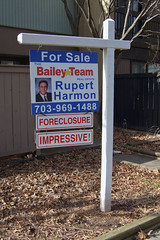
Image by joelogon via Flickr
By Renae Merle
The housing market is facing swelling ranks of homeowners who are seriously delinquent but have yet to lose their homes, and this is threatening a new wave of foreclosures that could hit just as the real estate market has begun to stabilize.
About 5 million to 7 million properties are potentially eligible for foreclosure but have not yet been repossessed and put up for sale. Some economists project it could take nearly three years before all these homes have been put on the market and purchased by new owners. And the number of pending foreclosures could grow much bigger over the coming year as more distressed borrowers become delinquent and then, if they can't obtain mortgage relief, wade through the foreclosure process, which often takes more than a year to complete.
As these foreclosed properties add to the supply of homes for sale, they could undercut housing prices, which have increased modestly through December, according to the most recent figures in the S&P/Case-Shiller home prices index. That rise partly reflected a slowdown in the flow of foreclosed homes onto the market.
The rate at which J.P. Morgan Chase seized properties, for example, peaked in the middle of 2008 and fell steadily last year, according to a February investor report. But the bank expects repossessions to increase this year, nearly doubling to 45,000 by the fourth quarter.
"Some of the positive housing data may not be signaling a true turning point, as many servicers are holding back on foreclosures and the related houses are not yet being offered for sale," said Diane Westerback, a managing director at Standard & Poor's. Westerback said it could take 33 months to clear the backlog.
Data released Thursday by RealtyTrac illustrate the dynamic. While banks repossessed fewer homes in February than a month earlier, borrowers continued to fall behind on their payments, adding to the inventory of properties headed toward foreclosure that have yet to be put on the market, said Daren Blomquist, RealtyTrac's spokesman.
"Just looking at the numbers, we would expect there to be a bigger percentage of properties" repossessed by banks by now, he said.
This "shadow market" reflects the increasing lag between defaults and foreclosures. Many lenders are struggling to keep up with the overwhelming number of borrowers who can't make their payments, and they're reluctant to rush repossessed homes onto the market when prices are depressed.
![Reblog this post [with Zemanta]](http://img.zemanta.com/reblog_a.png?x-id=fa7ffedf-bbc1-4d98-9c26-b1b3f4509390)